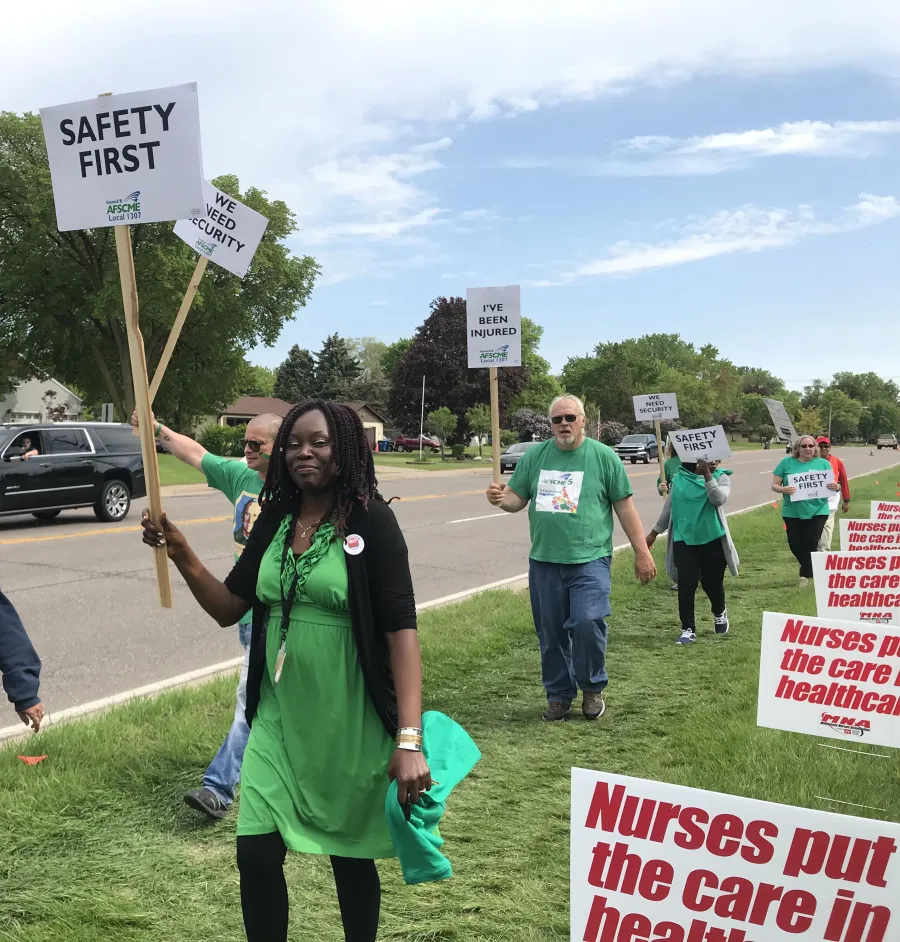AMRTC Workers Stand Together – and Win Big

Normal 0 false false false EN-US X-NONE X-NONE /* Style Definitions */ table.MsoNormalTable {mso-style-name:"Table Normal"; mso-tstyle-rowband-size:0; mso-tstyle-colband-size:0; mso-style-noshow:yes; mso-style-priority:99; mso-style-parent:""; mso-padding-alt:0in 5.4pt 0in 5.4pt; mso-para-margin-top:0in; mso-para-margin-right:0in; mso-para-margin-bottom:8.0pt; mso-para-margin-left:0in; line-height:107%; mso-pagination:widow-orphan; font-size:11.0pt; font-family:"Calibri",sans-serif; mso-ascii-font-family:Calibri; mso-ascii-theme-font:minor-latin; mso-hansi-font-family:Calibri; mso-hansi-theme-font:minor-latin;}
Last summer, members of AFSCME Local 1307 joined with members of MNA and MAPE at the Anoka Metro Regional Treatment Center (AMRTC) for an informational picket to call attention to unsafe working conditions at the facility. As a result of these actions, AMRTC added a new job classification – Safety Support Specialist – to the on-site staff.
Worker safety has been a problem for many years at AMRTC. The facility treats a diverse group of patients – including some who are inmates at correctional facilities across the state. Though most patients at AMRTC are not a threat to staff, a few pose a clear risk due to a history of aggressive behavior. But despite the escalating threat of violence, management refused to hear concerns, engage with staff, or even draft a plan to address the problem.
A violent attack at the facility was the final straw for AMRTC workers. In early May, a patient assaulted a nurse while she was providing him care. She was rendered unconscious and spent over a week in the hospital recovering.
“The next day, we set up the date for the informational picket,” said Lance Lemeiux, then-president of Local 1307. “The ball started to roll very fast after that. Everyone kind of understood we were at a tipping point here at AMRTC and something needed to be done.”
Faced with administrative roadblocks and intransigence from management, AMRTC staff – represented by AFSCME, MAPE, and MNA – joined together to fight back. Workers at AMRTC declared their intent to protest unsafe working conditions at the facility and to hold management accountable to protecting workers on the job.
Even before workers walked out, their actions got the administrators’ attention. “As soon as I delivered the email to management stating the date of the picket, meetings were set up,” said Lance. “They knew they had to do something.”
When the day of the picket arrived, hundreds of members from all three unions gathered in front of the facility to demand a solution to the long-standing security risks in their workplace. Amid honks of support from passing traffic, workers chanted, “Safety now, security always”.
It was not just AMRTC workers who held the line; a steady stream of community supporters and labor siblings came to march in solidarity throughout the day. Doctors and other non-union staff from AMRTC came out to show their support for the workers’ actions. Several elected officials from the Anoka area – from both sides of the partisan aisle – visited the picket to learn more and show their support for workers.
But it was the representation of all three unions that proved the true strength of the picket. “If it had just been one union out there, it would not have been as strong,” said Rachel Thurmer, the current president of Local 1307. “It shows management that we are all in this together, we are all concerned, and we are not going to back down.”
Workers were barely off the picket line before management made moves toward addressing the concerns they had raised. Management set about creating a new security position at AMRTC, with promises to workers that they would be included in the development process. But the process quickly hit a snag; management insisted on putting forward a job description that didn’t fully address the problem. In addition, the job was not attractive to applicants; the pay was low, and the hours extremely variable. Workers wanted the new role to be a separate classification with better pay, a stable schedule, and ongoing, high-quality training. They also insisted that these workers be included in the AFSCME contract, and that the new hires be AFSCME members.
But despite these objections, management moved forward. To their surprise, the union was right; no one applied for the position. So management had to return to the table and seek the advice of the union leaders in crafting a job description.
"I’d be lying if I said I didn’t have some happy feelings when they were forced to come back to the table,” said Lance. “In the beginning they [management] were adamant that it was within their rights to do it this way, so the fact that they basically conceded on everything that they held back on the first time – I was ecstatic. I couldn’t believe it.”
After months of discussion and advocacy, AMRTC employees finally had a breakthrough. In October, Hospital Administrator Rochelle Fischer announced the new role of Safety Support Specialist, a position that had included all the positive aspects labor leaders had fought for, and introduced the fifteen new specialists that had already been hired.
Labor leaders agree that their informational picket was essential in getting this position created. “I think the informational picket underlined how unified we were,” said Lance. “I don’t think management thought we’d have that kind of turnout, or that we felt as strong as we did.”
Though AMRTC workers have a long way to go to secure a safe and thriving workplace, this important step shows progress is possible when workers stand together. AFSCME members continue to work with their MNA and MAPE coworkers to pursue solutions that will ensure a safe and stable workplace for everyone.
“We say, ‘stronger together’ – it’s safety for everyone, not just safety for AFSCME,” said Rachel. “It doesn’t just apply to one union; it’s all of us.”
Normal 0 false false false EN-US X-NONE X-NONE /* Style Definitions */ table.MsoNormalTable {mso-style-name:"Table Normal"; mso-tstyle-rowband-size:0; mso-tstyle-colband-size:0; mso-style-noshow:yes; mso-style-priority:99; mso-style-parent:""; mso-padding-alt:0in 5.4pt 0in 5.4pt; mso-para-margin-top:0in; mso-para-margin-right:0in; mso-para-margin-bottom:8.0pt; mso-para-margin-left:0in; line-height:107%; mso-pagination:widow-orphan; font-size:11.0pt; font-family:"Calibri",sans-serif; mso-ascii-font-family:Calibri; mso-ascii-theme-font:minor-latin; mso-hansi-font-family:Calibri; mso-hansi-theme-font:minor-latin;}